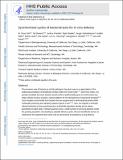| dc.contributor.author | Din, M. Omar | |
| dc.contributor.author | Prindle, Arthur | |
| dc.contributor.author | Selimkhanov, Jangir | |
| dc.contributor.author | Julio, Ellixis | |
| dc.contributor.author | Tsimring, Lev S. | |
| dc.contributor.author | Hasty, Jeff | |
| dc.contributor.author | Danino, Tal | |
| dc.contributor.author | Skalak, Matthew T. | |
| dc.contributor.author | Allen, Kaitlin N. | |
| dc.contributor.author | Atolia, Eta | |
| dc.contributor.author | Bhatia, Sangeeta N | |
| dc.date.accessioned | 2017-07-18T17:29:28Z | |
| dc.date.available | 2017-07-18T17:29:28Z | |
| dc.date.issued | 2016-08 | |
| dc.identifier.issn | 0028-0836 | |
| dc.identifier.issn | 1476-4687 | |
| dc.identifier.uri | http://hdl.handle.net/1721.1/110766 | |
| dc.description.abstract | The pervasive view of bacteria as strictly pathogenic has given way to an ppreciation of the widespread prevalence of beneficial microbes within the human body. Given this milieu, it is perhaps inevitable that some bacteria would evolve to preferentially grow in environments that harbor disease and thus provide a natural platform for the development of engineered therapies. Such therapies could benefit from bacteria that are programmed to limit bacterial growth while continually producing and releasing cytotoxic agents in situ. Here, we engineer a clinically relevant bacterium to lyse synchronously at a threshold population density and to release genetically encoded cargo. Following quorum lysis, a small number of surviving bacteria reseed the growing population, thus leading to pulsatile delivery cycles. We use microfluidic devices to characterize the engineered lysis strain and we demonstrate its potential as a drug deliver platform via co-culture with human cancer cells in vitro. As a proof of principle, we track the bacterial population dynamics in ectopic syngeneic colorectal tumors in mice. The lysis strain exhibits pulsatile population dynamics in vivo, with mean bacterial luminescence that remained two orders of magnitude lower than an unmodified strain. Finally, guided by previous findings that certain bacteria can enhance the efficacy of standard therapies, we orally administer the lysis strain, alone or in combination with a clinical chemotherapeutic, to a syngeneic transplantation model of hepatic colorectal metastases. We find that the combination of both circuit-engineered bacteria and chemotherapy leads to a notable reduction of tumor activity along with a marked
survival benefit over either therapy alone. Our approach establishes a methodology for leveraging the tools of synthetic biology to exploit the natural propensity for certain bacteria to colonize disease sites. | en_US |
| dc.description.sponsorship | National Institute of General Medical Sciences (U.S.) (GM069811) | en_US |
| dc.description.sponsorship | San Diego Center for Systems Biology (P50 GM085764) | en_US |
| dc.description.sponsorship | National Cancer Institute (U.S.). Swanson Biotechnology Center (Koch Institute Support Grant (P30-CA14051)) | en_US |
| dc.description.sponsorship | National Institute of Environmental Health Sciences (Core Center Grant (P30- ES002109)) | en_US |
| dc.description.sponsorship | National Institutes of Health (U.S.) (NIH Pathway to Independence Award NIH (K99 CA197649-01)) | en_US |
| dc.description.sponsorship | Misrock Postdoctoral fellowship | en_US |
| dc.description.sponsorship | National Defense Science and Engineering Graduate (NDSEG) Fellowship | en_US |
| dc.language.iso | en_US | |
| dc.publisher | Nature Publishing Group | en_US |
| dc.relation.isversionof | http://dx.doi.org/10.1038/nature18930 | en_US |
| dc.rights | Article is made available in accordance with the publisher's policy and may be subject to US copyright law. Please refer to the publisher's site for terms of use. | en_US |
| dc.source | PMC | en_US |
| dc.title | Synchronized cycles of bacterial lysis for in vivo delivery | en_US |
| dc.type | Article | en_US |
| dc.identifier.citation | Din, M. Omar, Tal Danino, Arthur Prindle, Matt Skalak, Jangir Selimkhanov, Kaitlin Allen, Ellixis Julio, et al. “Synchronized Cycles of Bacterial Lysis for in Vivo Delivery.” Nature 536, no. 7614 (July 20, 2016): 81–85. | en_US |
| dc.contributor.department | Massachusetts Institute of Technology. Institute for Medical Engineering & Science | en_US |
| dc.contributor.department | Harvard University--MIT Division of Health Sciences and Technology | en_US |
| dc.contributor.department | Massachusetts Institute of Technology. Department of Biology | en_US |
| dc.contributor.department | Massachusetts Institute of Technology. Department of Electrical Engineering and Computer Science | en_US |
| dc.contributor.department | Massachusetts Institute of Technology. Department of Mechanical Engineering | en_US |
| dc.contributor.mitauthor | Danino, Tal | |
| dc.contributor.mitauthor | Skalak, Matthew T. | |
| dc.contributor.mitauthor | Allen, Kaitlin N. | |
| dc.contributor.mitauthor | Atolia, Eta | |
| dc.contributor.mitauthor | Bhatia, Sangeeta N | |
| dc.relation.journal | Nature | en_US |
| dc.eprint.version | Author's final manuscript | en_US |
| dc.type.uri | http://purl.org/eprint/type/JournalArticle | en_US |
| eprint.status | http://purl.org/eprint/status/PeerReviewed | en_US |
| dspace.orderedauthors | Din, M. Omar; Danino, Tal; Prindle, Arthur; Skalak, Matt; Selimkhanov, Jangir; Allen, Kaitlin; Julio, Ellixis; Atolia, Eta; Tsimring, Lev S.; Bhatia, Sangeeta N.; Hasty, Jeff | en_US |
| dspace.embargo.terms | N | en_US |
| dc.identifier.orcid | https://orcid.org/0000-0001-7302-4394 | |
| dc.identifier.orcid | https://orcid.org/0000-0002-1293-2097 | |
| mit.license | PUBLISHER_POLICY | en_US |
| mit.metadata.status | Complete | |
